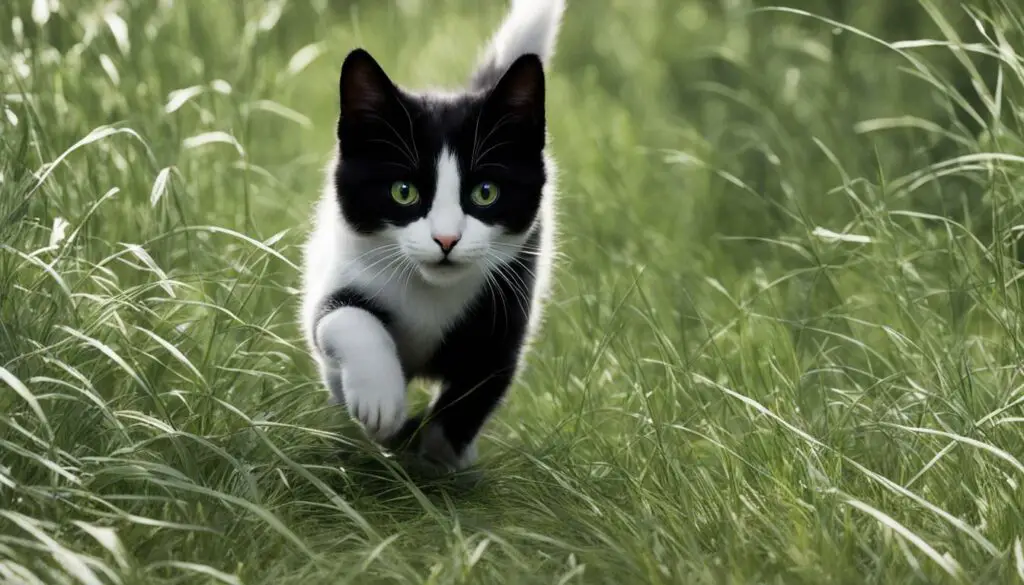Have you ever wondered why cats sometimes run away when you try to pet them? It’s a common behavior that can leave cat owners feeling puzzled or even rejected. But fear not! There are several reasons why cats may exhibit this behavior, and by understanding their psychology and instincts, we can help create a more harmonious bond with our feline friends.
When approaching a cat, it’s essential to remember that each cat is an individual with their own unique set of preferences and sensitivities. Some cats may be more skittish and cautious by nature, while others may have had negative experiences in the past that have made them wary of human touch.
Cats are known for their strong feline instincts, which include a natural inclination for independence and a cautious approach to potentially threatening situations. Being approached by a stranger can be perceived as a threat, triggering the cat’s flight response. If a cat feels scared or uncomfortable, their instinct is to run away to protect themselves.
Understanding cat body language is crucial in deciphering their emotions and intentions. Cats communicate through subtle cues such as ear position, tail movements, and overall body posture. A cat that feels fearful or threatened may exhibit signs like flattened ears, dilated pupils, or a crouched posture.
Approaching cats with patience and respect is key to gaining their trust. It’s important to let the cat take the lead and initiate contact on their terms. Avoid sudden movements or loud noises that may startle them. By creating a calm and safe environment, providing positive experiences, and respecting their boundaries, you can gradually build trust and help your cat feel more comfortable with petting and human interaction.
Key Takeaways:
- Cats may run away when approached due to fear, stress, or individual preferences.
- Understanding cat body language can help interpret their behavior and emotions.
- Patience and respect are crucial in building trust with cats.
- Creating a calm and safe environment can help cats feel more comfortable.
- Each cat is unique, and their preferences should be respected.
The Importance of Socialization for Cats
When it comes to understanding why some cats run away when approached, socialization plays a crucial role. Socialization, especially during a kitten’s early stages of development, is essential in shaping their behavior and how they interact with humans. The process of socializing kittens involves exposing them to various experiences, including human touch, to help them develop positive associations and build a strong foundation for future interactions.
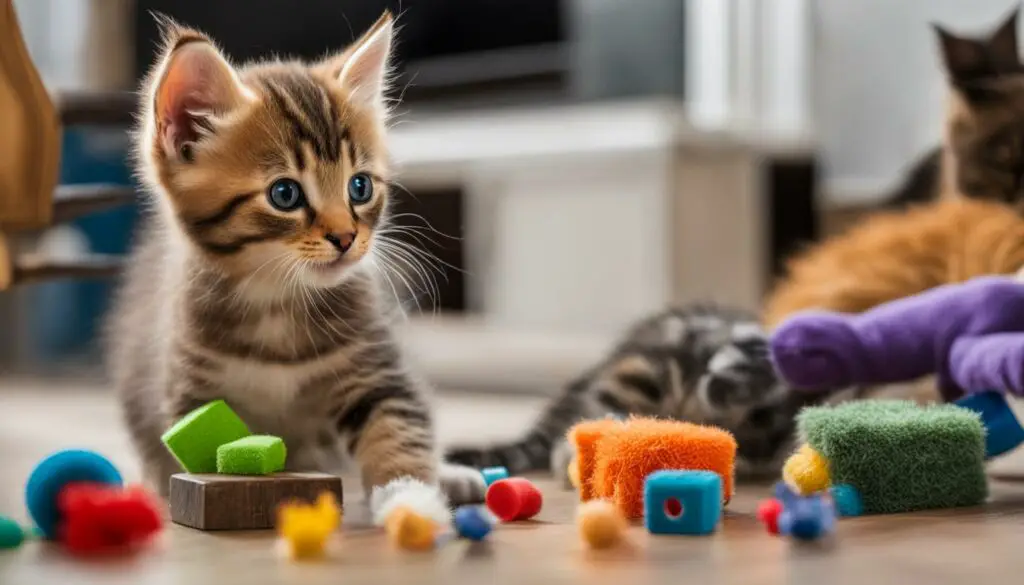
During the critical period of 2-7 weeks, kittens are most receptive to socialization. This is when they need to be exposed to gentle handling and human touch to understand that it can be a pleasurable experience. By carefully introducing kittens to new environments, people, and experiences, we can help them become comfortable and confident around humans. This early socialization helps prevent them from becoming skittish or fearful when approached later in life.
The Benefits of Socializing Kittens:
- Developing a positive association with human touch
- Reducing fear and anxiety in social situations
- Building confidence and trust in humans
- Preparing kittens for a lifetime of positive interactions
By prioritizing kitten socialization and providing them with a nurturing and positive environment, we can set them up for a lifetime of healthy interactions with humans. It’s important to remember that socialization isn’t limited to kittens. Even older cats can benefit from gentle exposure to new experiences and gradual socialization.
Understanding the importance of socialization and providing a supportive environment for our feline companions can help prevent cats from running away when approached. By nurturing positive associations with human touch and gradually building trust, we can strengthen the bond between cats and their owners.
The Role of Fear and Stress in Cats’ Behavior
When it comes to understanding why cats run away when approached, it is crucial to consider the role of fear and stress in their behavior. Cats can be highly sensitive creatures, and their reactions to certain stimuli, such as humans approaching them, are often influenced by fear and stress. Traumatic events or poorly treated experiences in the past can lead cats to develop a fear of humans, causing them to run away when approached. Additionally, changes in their environment or stressful situations can also trigger a flight response.
Recognizing signs of fear and stress in cats is important for understanding their behavior. Cats may display various body language cues, such as flattened ears, dilated pupils, or raised fur, when they feel threatened or anxious. It is crucial to pay attention to these cues and adjust our approach accordingly to make cats feel more comfortable.
Understanding the role of fear and stress in cats’ behavior is essential in building a trusting relationship with them. By providing a safe and calm environment, respecting their boundaries, and using positive reinforcement, we can help cats feel more secure and reduce their likelihood of running away when approached
Table: Examples of cat body language cues related to fear and stress
| Cat Body Language | Meaning |
|---|---|
| Flattened ears | Sign of fear or anxiety |
| Dilated pupils | Indicator of stress or fear |
| Raised fur | Display of fear or aggression |
Understanding the complex interplay between fear, stress, and cat behavior is key to creating a harmonious environment for our feline companions. By acknowledging and addressing their fears and sources of stress, we can help cats feel safe, build trust, and foster a stronger bond with them.
Understanding Cat Personalities and Preferences
Each cat has a unique personality and may have different preferences when it comes to being petted or approached. Some cats are naturally more shy or aloof, while others may be noise-sensitive or independent. It’s important to respect a cat’s individual preferences and not force them into unwanted interactions.
Cat Personalities:
- Shy cats
- Noise-sensitive cats
- Aloof cats
- Independent cats
Shy cats are often cautious and may need more time to warm up to new people or situations. They may prefer to hide or observe from a distance before feeling comfortable enough to engage. Noise-sensitive cats may startle easily and may prefer quieter environments or areas where they can retreat when they feel overwhelmed. Aloof cats tend to be more independent and may not seek as much attention or physical affection from their owners. They may appreciate their personal space and prefer interactions on their own terms. Independent cats are self-reliant and may have a more aloof demeanor. They are often content with minimal interaction and may value their alone time.
It’s important for cat owners to understand and recognize their cat’s personality and preferences in order to provide them with a comfortable and stress-free environment. By respecting their boundaries and being mindful of their comfort levels, cat owners can create a positive and trusting relationship with their feline companions.
Table: Cat Personalities and Preferences
| Cat Personality | Cat Preferences |
|---|---|
| Shy cats | Prefer gradual introductions, quiet environments, and space to hide |
| Noise-sensitive cats | Prefer quieter environments, avoid sudden loud noises or movements |
| Aloof cats | Prefer personal space, may not seek as much attention or physical affection |
| Independent cats | Self-reliant, enjoy alone time, may not seek as much interaction |
Understanding and accommodating cat personalities and preferences is essential for creating a harmonious and enjoyable relationship with your feline companion. By allowing them to dictate the terms of interaction and providing them with the space and environment that aligns with their comfort levels, you can build trust and strengthen your bond with your cat.
The Role of Playfulness in Cats’ Behavior
Cats are known for their playful nature, and this behavior plays a crucial role in their overall well-being. Playtime is not only a source of entertainment for your feline friend but also serves as a means of exercise, mental stimulation, and bonding. Understanding the importance of playfulness in cats’ behavior can help you engage them in interactive play and strengthen your relationship.
Interactive play is especially beneficial for cats because it mimics the hunting instincts they would normally use in the wild. Through play, cats can satisfy their natural prey drive and release excess energy. This can help prevent behavioral issues such as aggression or destructive behavior that may arise from boredom or frustration.
Engaging cats in play also allows for quality bonding time. It creates positive associations with you as their playmate, helping to build trust and strengthen your cat-human bond. Whether it’s using interactive toys, feather wands, or laser pointers, finding activities that capture your cat’s interest and encourage them to pounce, chase, and jump can provide hours of enjoyment for both of you.

Benefits of Interactive Play for Cats:
- Physical exercise and mental stimulation
- Prevents obesity and related health issues
- Reduces stress and anxiety
- Promotes socialization and bonding
“Playtime with your cat is not just fun; it’s an essential part of their well-being. By providing interactive play opportunities, you can keep them physically and mentally stimulated while strengthening your bond.”
| Common Interactive Toys | Benefits |
|---|---|
| Feather Wands | Simulates hunting behavior |
| Treat Dispenser Toys | Provides mental stimulation |
| Puzzle Toys | Challenges problem-solving skills |
| Laser Pointers | Encourages chasing and pouncing |
Building Trust with Your Cat
Building trust with your cat is essential for creating a strong and loving bond. Cats are sensitive creatures, and earning their trust takes time, patience, and a cat-friendly approach. By understanding their needs and respecting their boundaries, you can create a safe and secure environment where your cat feels comfortable and loved.
One crucial aspect of building trust with your cat is to let them initiate interactions. Cats are independent by nature, and they appreciate having control over their social interactions. Allow your cat to approach you when they feel ready, and avoid forcing physical contact. This approach shows your cat that you respect their personal space and builds a foundation of trust.
Positive reinforcement is another effective way to earn your cat’s trust. Reward your cat with treats, praise, or playtime when they exhibit desirable behaviors. This positive association helps your cat associate your presence with positive experiences and encourages them to seek out interactions with you. Be consistent with your rewards and avoid using punishment, as it can undermine trust and create fear or anxiety.
Creating a Safe Space for Your Cat
Creating a safe space for your cat is crucial for building trust. Cats need a retreat where they can feel secure and comfortable. Provide enclosed cat beds, cardboard boxes with holes, or cozy hiding spots where your cat can go when they need alone time. These safe spaces give your cat a sense of security and control over their environment.
| Cat’s Safe Space Essentials | Description |
|---|---|
| Enclosed cat bed | A private and cozy bed with a roof or sides that offers protection and comfort. |
| Cardboard box | A simple and affordable hiding spot that cats find comforting. |
| High perches | A vertical space that allows your cat to observe their environment from a safe distance. |
Building trust with your cat takes time and patience. It’s important to remember that each cat is unique, and the process may vary. By following a cat-friendly approach, providing positive reinforcement, and creating a safe space, you can build a strong bond and earn your cat’s trust. Remember, the key is to be patient, understanding, and respectful of your cat’s individual needs.
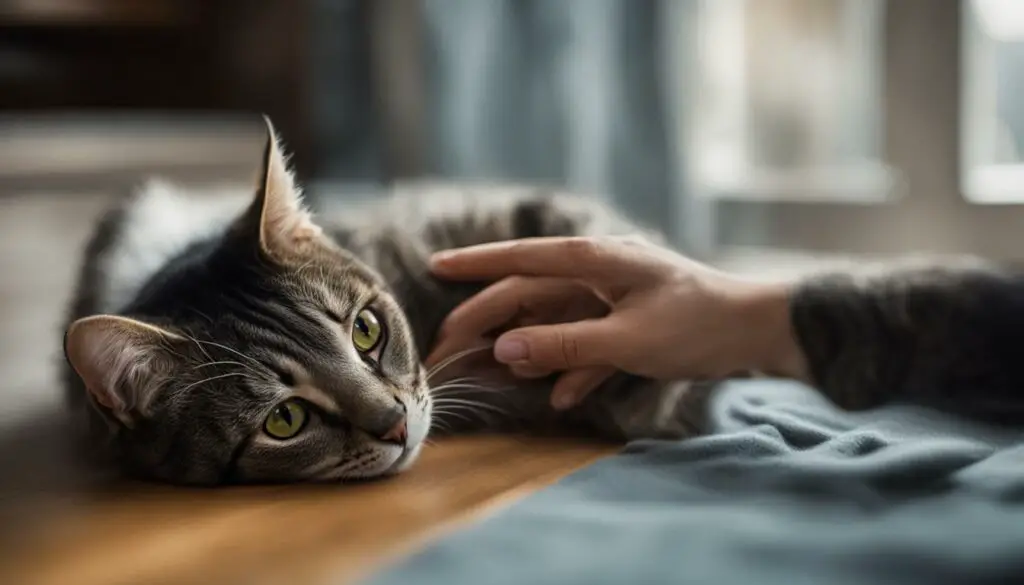
Creating a Safe Environment for Your Cat
Creating a safe and comfortable environment is essential for keeping your cat happy and secure. Cats need spaces where they can retreat and feel protected, especially when they feel overwhelmed or anxious. Providing safe hiding places and creating a cat-friendly environment can help build your cat’s confidence and foster a sense of security.
One way to create a safe space for your cat is by providing enclosed cat beds or cardboard boxes with holes. These cozy hiding spots give cats a sense of privacy and safety, allowing them to relax and recharge. Placing these hiding places in quiet and low-traffic areas of your home will help ensure that your cat can retreat to their safe space undisturbed.
Additionally, offering high perches can give cats a sense of security and control over their environment. Cat trees or shelves placed strategically near windows or in quiet corners allow cats to observe their surroundings from a safe vantage point. These elevated perches not only provide a physical retreat but also fulfill a cat’s natural instinct to be in an elevated position.
It’s important to note that punishment should never be used as a means to modify a cat’s behavior or enforce boundaries. Punishment can cause fear and anxiety in cats, leading to defensive behaviors and even exacerbating the problem behavior. Instead, focus on positive reinforcement by rewarding your cat’s desired behaviors with treats or praise, and redirecting unwanted behaviors in a gentle and patient manner.
In summary, creating a safe environment for your cat involves providing hiding places, high perches, and avoiding punishment. By offering these safe spaces and avoiding negative reinforcement, you can help your cat feel comfortable and confident in their surroundings. A secure and welcoming environment is crucial for a happy and well-adjusted cat.
| Key Tips for Creating a Safe Environment for Your Cat |
|---|
| Provide enclosed cat beds or cardboard boxes with holes as hiding places |
| Offer high perches, such as cat trees or shelves, for cats to observe their surroundings |
| Avoid punishment and focus on positive reinforcement |
Recognizing Signs of Illness in Cats
As cat owners, it’s crucial to be vigilant in monitoring our feline friends for any signs of illness. Cats are masters at hiding their symptoms, so it’s important to pay attention to subtle changes in their behavior and physical appearance. By recognizing the signs of illness early on, we can seek veterinary care promptly and ensure our cats receive the necessary treatment for a speedy recovery.
Here are some common signs of illness in cats to watch out for:
- Changes in appetite: A sudden increase or decrease in appetite could be a sign of an underlying health issue.
- Weight loss or gain: Unexplained weight loss or gain can indicate a variety of medical conditions.
- Lethargy: If your cat is unusually tired or lacks energy, it may be a sign of illness.
- Changes in litter box habits: Difficulty urinating, frequent urination, or blood in the urine may indicate a urinary tract infection or other health problems.
- Vomiting or diarrhea: Occasional vomiting or diarrhea is normal, but if it becomes frequent or prolonged, it could be a sign of an underlying issue.
- Coughing or sneezing: Persistent coughing or sneezing may indicate respiratory problems or allergies.
- Changes in behavior: Any significant changes in your cat’s behavior, such as increased aggression or withdrawal, should be taken seriously.
If you notice any of these signs or have concerns about your cat’s health, it’s crucial to seek veterinary care. A qualified veterinarian can perform a thorough examination, run diagnostic tests, and provide appropriate treatment for your cat’s specific condition.
| Signs of Illness | Possible Causes |
|---|---|
| Weight loss or gain | Thyroid problems, diabetes, gastrointestinal issues |
| Lethargy | Anemia, infections, kidney disease |
| Changes in appetite | Dental problems, liver disease, gastrointestinal disorders |
| Increased thirst and urination | Kidney disease, diabetes, urinary tract infections |
| Coughing or sneezing | Respiratory infections, allergies, asthma |
| Vomiting or diarrhea | Gastrointestinal issues, food allergies, parasites |
“Early detection of illnesses in cats can greatly improve their chances of a successful recovery. Regular veterinary check-ups and proactive monitoring of your cat’s health are essential for their overall well-being.”
Remember, cats are masters at hiding their pain and discomfort, so it’s crucial to be observant and proactive in assessing their health. Regular check-ups, a balanced diet, and providing a stress-free environment can go a long way in keeping our feline companions healthy and happy.
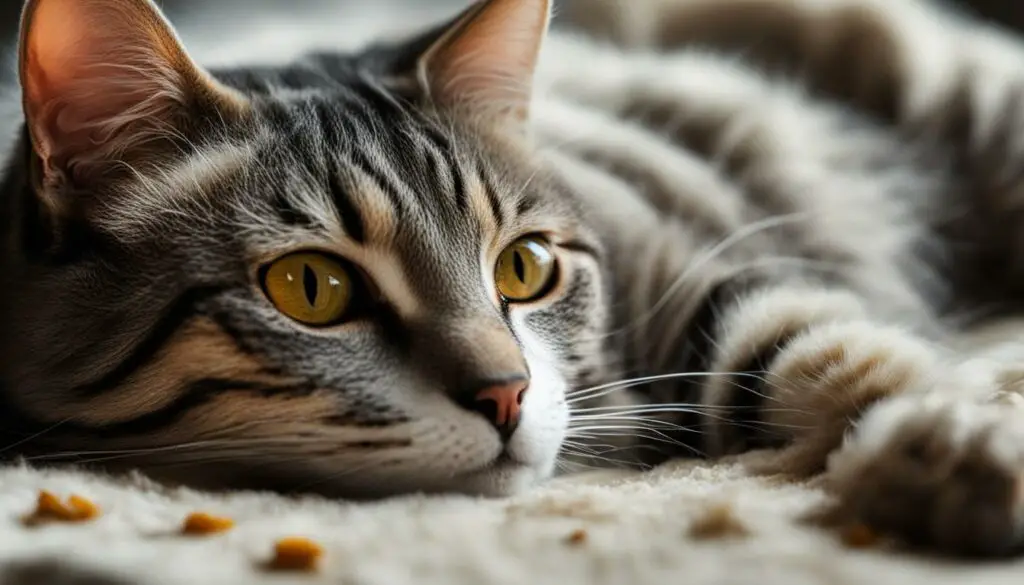
Addressing Stress in Cats
Stress can significantly impact a cat’s behavior and overall well-being. As a responsible cat owner, it’s important to understand the common stress triggers in cats and take proactive steps to reduce their stress levels. By creating a calm and comfortable environment, making necessary environmental changes, and implementing additional cat-friendly solutions, you can help your feline friend feel more relaxed and secure.
Common Stress Triggers in Cats
- Loud noises: Cats are naturally sensitive to loud noises, which can cause stress and anxiety. Common triggers include thunderstorms, fireworks, and household appliances.
- Changes in routine: Cats thrive on routine, so any significant changes in their daily schedule or environment can lead to stress. This includes moving to a new home, introducing a new pet or family member, or even rearranging furniture.
- Lack of stimulation: Boredom and lack of mental or physical stimulation can contribute to stress in cats. Providing interactive toys, scratching posts, and plenty of playtime can help alleviate stress and keep your cat engaged.
- Limited safe spaces: Cats need designated safe spaces where they can retreat and feel secure. If your cat doesn’t have access to hiding spots or high perches, they may feel vulnerable, leading to increased stress levels.
By identifying these common stress triggers, you can begin taking steps to reduce stress and promote a calm environment for your cat. Remember, every cat is unique, so it’s essential to pay attention to their individual needs and preferences.
| Stress Trigger | Solution | |
|---|---|---|
| 1 | Loud Noises | Provide a quiet and secure space for your cat during loud events. Consider using white noise machines or calming music to drown out disruptive sounds. |
| 2 | Changes in Routine | Introduce changes gradually to allow your cat to adapt. Maintain a consistent daily routine as much as possible to provide a sense of stability. |
| 3 | Lack of Stimulation | Offer a variety of interactive toys, puzzles, and scratching posts to keep your cat mentally and physically engaged. Rotate toys regularly to keep them interesting. |
| 4 | Limited Safe Spaces | Provide multiple hiding spots, such as cat trees, enclosed beds, or cardboard boxes with holes. These safe spaces offer your cat a sense of security and help reduce stress. |
Additionally, there are cat-friendly solutions that can help alleviate stress and anxiety in your furry companion. These solutions include the use of pheromone diffusers or sprays, herbal remedies, and even behavioral modification techniques. Consulting with a veterinarian or a cat behaviorist can provide valuable guidance in implementing these solutions effectively.
Remember, reducing stress in cats is an ongoing process that requires patience and observation. By addressing stress triggers and providing a safe and comfortable environment, you can help your cat lead a happier and more relaxed life.

Understanding Cat Body Language
When it comes to interacting with cats, understanding their body language is crucial. Cats communicate through a variety of signals, and being able to interpret these cues can help you better understand their emotions and prevent them from running away when approached.
Cats often exhibit signs of fear when they feel threatened or uncomfortable. Some common signs of fear in cats include flattened ears, dilated pupils, and a crouched or hunched body posture. If you notice these signs, it’s important to give the cat space and avoid any sudden movements or loud noises that may escalate their fear.
Aggression is another behavior that cats may display when approached. Signs of aggression in cats can include hissing, growling, or swatting with their paws. If a cat shows these signs, it’s best to back away and give them the space they need to calm down.
| Signs of fear in cats | Signs of aggression in cats |
|---|---|
| – Flattened ears | – Hissing |
| – Dilated pupils | – Growling |
| – Crouched or hunched body posture | – Swatting with paws |
Understanding cat body language is not only important for your own safety, but it also allows you to create a more positive and comfortable environment for your cat. By respecting their signals and providing a calm and stress-free space, you can build trust and strengthen your bond with your feline friend.
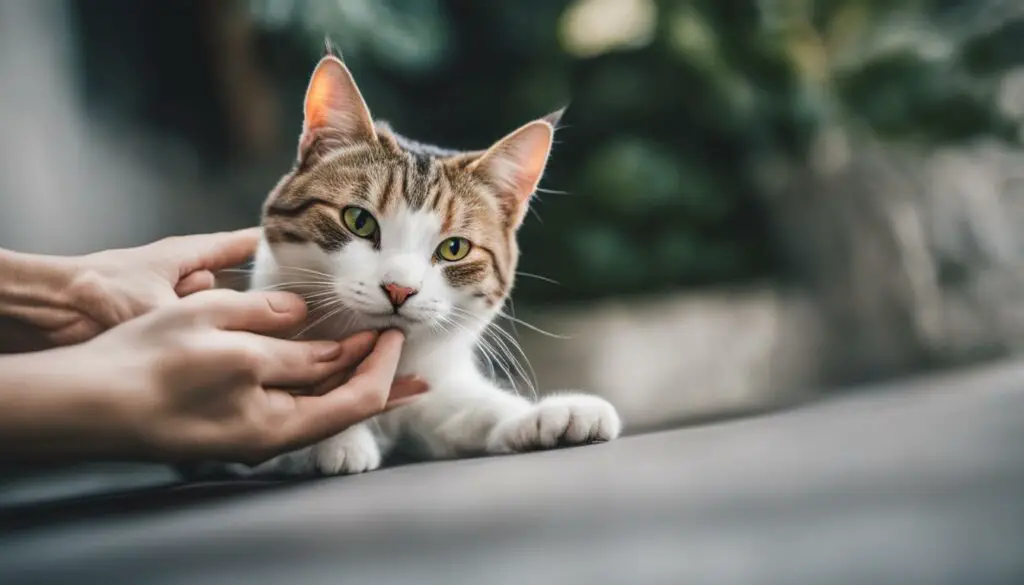
Importance of Cat Body Language
Recognizing and responding to cat body language is crucial for effective communication with our feline companions. It helps us understand their emotions, alleviate their stress, and foster a positive relationship. By paying attention to their subtle cues, we can ensure that our interactions with cats are enjoyable and respectful.
- Look for signs of fear, such as flattened ears, dilated pupils, or a tense body posture. If a cat is displaying these signs, it’s important to give them space and avoid any actions that may escalate their fear.
- Aggression can be displayed through hissing, growling, or swatting. If a cat is exhibiting aggressive behavior, it’s best to back away and give them time to calm down.
- Positive body language includes relaxed ears, slow blinking, and a content body posture. These signals indicate that a cat feels comfortable and at ease in their environment.
“Understanding cat body language is like speaking their silent but meaningful language. It allows us to create a safe and trusting environment for our furry companions.” – Cat Lover
By familiarizing ourselves with cat body language, we can better understand their needs and ensure that our interactions with them are positive and mutually satisfying.
Patience and Persistence with Cats
When it comes to dealing with cats that run away when approached, patience and persistence are essential. It’s important to remember that each cat is unique and may have their own fears or discomforts. By approaching them with understanding and respect, you can gradually make progress in overcoming their fear or discomfort.
A persistent approach is key when building trust with a cautious cat. Start by creating a calm and inviting environment, with minimal noise and distractions. Allow the cat to initiate interactions and avoid sudden movements that may startle them. Offer treats or rewards as positive reinforcement, reinforcing the idea that interacting with you is a pleasant experience.
Overcoming fear or discomfort requires gradual progress. Take small steps and allow the cat to set the pace. Initially, focus on simply being present in their space without touching or approaching them. As they become more comfortable, you can slowly introduce gentle petting, always paying attention to their body language for signs of stress or unease.
Remember, building trust and overcoming fear takes time. Be patient and celebrate even the smallest victories. With persistence and a gradual approach, you can help your cat feel more comfortable and secure, fostering a strong and loving bond between you and your feline friend.
“Approaching a cat with patience and persistence is like earning their trust penny by penny. It may take time, but every effort counts in building a strong bond with your furry companion.” – Cat Lover
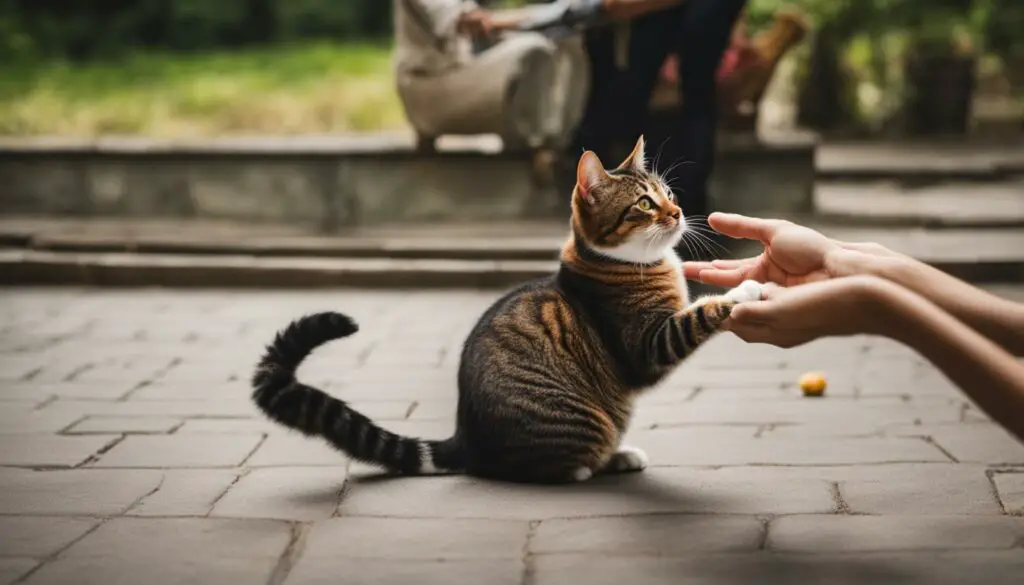
| Benefits of Patience and Persistence with Cats | Actions to Take |
|---|---|
| Building trust and a strong bond | Allow the cat to initiate interactions and provide positive reinforcement through treats and rewards |
| Reducing fear and discomfort | Gradually introduce gentle petting and always respect their boundaries |
| Creating a calm and inviting environment | Minimize noise and distractions, allowing the cat to feel safe and secure |
Seeking Professional Help for Cat Behavior Issues
If you’re having difficulty addressing your cat’s behavior issues on your own, it may be time to seek professional help. A cat behaviorist or a veterinary behaviorist can provide specialized training and guidance to help you understand and modify your cat’s behavior. These experts have a deep understanding of feline psychology and can offer tailored solutions to address your cat’s specific needs.
A cat behaviorist is a professional who specializes in understanding and modifying cat behavior. They can help you identify the underlying causes of your cat’s behavior issues and develop a personalized behavior modification plan. A behaviorist will work closely with you to address problems such as aggression, litter box issues, excessive meowing, or anxiety.
A veterinary behaviorist is a veterinarian who has received additional training in animal behavior. They can diagnose and treat complex behavior problems that may have underlying medical causes. A veterinary behaviorist can work with you and your veterinarian to develop a comprehensive treatment plan that includes both behavioral and medical interventions if necessary.
Specialized cat training programs are another option for addressing cat behavior issues. These programs are typically conducted by certified trainers who have extensive experience working with cats. They can provide you with the skills and techniques needed to modify your cat’s behavior effectively.

When to Seek Professional Help
If your cat’s behavior issues are severe, persistent, or causing significant disruption in your household, it’s a good idea to seek professional help. Here are some signs that indicate it may be time to consult a cat behaviorist or veterinary behaviorist:
- Your cat displays aggressive behavior, such as biting or scratching.
- Your cat is consistently avoiding social interaction or hiding for extended periods.
- Your cat is exhibiting destructive behavior, such as excessive scratching or urine marking.
- Your cat is showing signs of anxiety or fear, such as excessive grooming or excessive vocalization.
- Your cat’s behavior issues have not improved with previous attempts at behavior modification.
Remember, seeking professional help is not a sign of failure as a cat owner. It’s a proactive step to ensure the well-being of your cat and a more harmonious relationship between you and your feline companion.
Tips for Successful Cat Interaction
When it comes to interacting with cats, taking a cat-friendly approach is key to creating positive experiences for both you and your feline friend. Here are some tips to help ensure successful interactions:
- Respect their boundaries: Cats are independent creatures and may have different comfort levels when it comes to physical contact. Always let the cat set the pace and initiate the interaction. Avoid sudden movements or loud noises that may startle them.
- Provide positive experiences: Offer treats, engage in interactive play, and use a gentle touch when petting your cat. This will help them associate your presence with positive experiences and build trust over time.
- Observe their body language: Pay attention to your cat’s body language, as it can provide valuable insights into their mood and comfort level. Look out for signs of relaxation such as a relaxed tail, purring, or rubbing against you. Conversely, watch for signs of discomfort like flattened ears or a flicking tail.
- Give them space: Cats need their own safe spaces where they can retreat and feel secure. Respect their need for alone time and provide them with cozy hiding spots, elevated perches, or enclosed beds.
“To have successful interactions with cats, it’s important to let them set the pace and initiate the interaction.”
Remember, each cat is unique, with their own preferences and sensitivities. What works for one cat may not work for another, so it’s important to adjust your approach accordingly. By following these tips and being patient and attentive, you can create a positive and enriching environment for your cat, fostering a strong bond and mutual trust.

Understanding the Complexity of Cat Behavior
Understanding cat behavior is a fascinating and complex subject. It involves delving into the intricate workings of feline instincts, their innate nature, and how past experiences shape their behavior. Cats are known for their independence and cautious nature, which can influence their response when approached by humans.
While some cats may run away when approached, it’s crucial to remember that there are various factors at play. Each cat has unique instincts and personalities, which can impact their behavior. Some cats may be more prone to fear or stress due to past traumatic experiences, while others may have a natural inclination towards skittishness or aloofness.
Recognizing and respecting a cat’s instincts and nature is vital for building a strong bond and avoiding unwanted behavior. By understanding their body language, providing a safe environment, and using positive reinforcement techniques, you can help your cat feel more comfortable and secure. It’s also important to be patient and persistent, as building trust and overcoming fear or discomfort takes time.
Conclusion
In conclusion, understanding cat behavior is essential for building a strong bond and trust with our feline companions. Cats may run away when approached due to various reasons, such as fear, stress, or individual preferences. By respecting their boundaries and providing a safe environment, we can create a positive and loving relationship with our cats.
Building trust with cats takes time and patience. By letting them set the pace and initiating interactions on their terms, we can establish a sense of comfort and security. Paying attention to their body language and providing positive experiences through play, treats, and gentle petting can further strengthen the cat-human bond.
It’s important to remember that cat behavior is complex and influenced by a combination of factors, including instincts and past experiences. Each cat has its unique personality and preferences, so it’s crucial to adjust our approach accordingly. Professional help from cat behaviorists or veterinary behaviorists can also be beneficial in addressing specific behavior issues.
In summary, by understanding and respecting cat behavior, we can create a harmonious and fulfilling relationship with our feline friends. With patience, persistence, and positive experiences, we can overcome any challenges and form a deep and lasting bond based on trust and mutual understanding.
FAQ
Why do cats run away when you try to pet them?
Cats may run away when approached for various reasons, including fear, stress, and individual preferences.
How can socialization affect a cat’s behavior?
Socialization plays a crucial role in a cat’s behavior. Kittens need to be socialized to human touch between the ages of 2-7 weeks to learn that being held and pet by humans is a pleasurable experience.
What role does fear and stress play in cats’ behavior?
Fear and stress can cause cats to run away when approached. Cats that have had traumatic experiences or have been poorly treated in the past may develop a fear of humans. Cats can also be sensitive to changes in their environment or stressful situations.
Do cats have different personalities and preferences?
Yes, each cat has a unique personality and may have different preferences when it comes to being petted or approached. Some cats are naturally more shy or aloof, while others may be sensitive to loud noises.
Why do some cats engage in playful behavior when approached?
Cats may run away as part of their playful behavior. Some cats enjoy playing hide-and-seek or engaging in interactive play with their owners.
How can I build trust with my cat?
Building trust with your cat is crucial to prevent them from running away when approached. Let your cat initiate interactions, pay attention to their body language, and respect their boundaries. Positive reinforcement, such as treats or rewards, can also help reinforce positive interactions.
How can I create a safe environment for my cat?
Cats need access to safe spaces where they can retreat and feel secure. Providing enclosed cat beds or cardboard boxes with holes, as well as high perches, can give cats a sense of safety. Avoid punishment, as it can make cats fearful and worsen their behavior.
What are signs of illness in cats?
Cats may run away when approached if they are ill or injured. If a cat starts exhibiting unusual behavior, such as hiding more than usual or behaving out of character, it’s important to seek veterinary care.
How can I address stress in my cat?
Cats can be easily stressed by various factors. Identifying and addressing these stress triggers is important to help cats feel more comfortable and prevent them from running away when approached. Creating a calm and stable environment and providing cat-friendly solutions can help reduce stress.
How can I understand my cat’s body language?
Understanding cat body language can help interpret their behavior and prevent them from running away. Cats may exhibit signs of fear or aggression, such as flattened ears, dilated pupils, or raised fur. By paying attention to these cues, you can adjust your approach and make your cat feel more comfortable.
What should I do if my cat constantly runs away when approached?
Patience and persistence are key when dealing with cats that run away when approached. It may take time for a cat to overcome their fear or discomfort and feel more comfortable with petting and human interaction. By gradually building trust and respecting their boundaries, you can help your cat become more comfortable over time.
When should I seek professional help for my cat’s behavior?
If you’re having difficulty addressing your cat’s behavior issues on your own, seeking professional help from a cat behaviorist or a veterinary behaviorist can be beneficial. These experts can provide specialized training and guidance to help you understand and modify your cat’s behavior.
What are some tips for successful cat interaction?
To have successful interactions with cats, it’s important to let them set the pace and initiate the interaction. Avoid sudden movements or loud noises that can startle them. Provide positive experiences through play, treats, and gentle petting. Each cat is unique, so adjust your approach based on their individual preferences.
Is cat behavior complex?
Yes, cat behavior is complex and influenced by a combination of factors, including instincts, past experiences, and individual personalities. Understanding and respecting their instincts and nature is essential for forming a strong bond with your cat.

